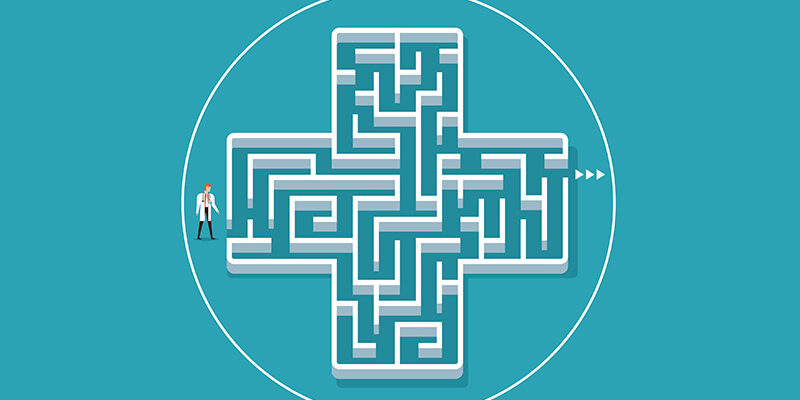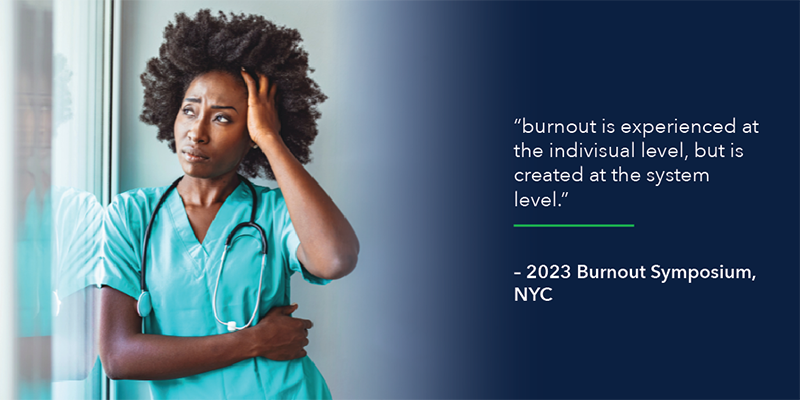
Liz Griffith
uPerform
Director, EHR Education
Welcome to the uPerform Thought Leader series, a collection of articles penned by industry leaders committed to improving health IT training and sharing their knowledge. Liz Griffith serves as the Director of EHR Education at uPerform and is a fiercely passionate champion for health IT training. Prior to her role at uPerform, Liz served as the Director of Customer Insights at KLAS Research, leading EHR satisfaction consulting and measurements.
I recently found myself meeting with my entire executive team and a group of KLAS Research consultants discussing the current research regarding EHR satisfaction, the impact the EHR has on clinician burnout and how self-directed training is making a big impact in both of these areas. While reviewing the burnout data and how it is contributing to increases in turnover, I kept getting befuddled and saying burnover. While it was only mildly embarrassing and we all had a good chuckle, it is actually an important phrase carrying severe financial consequences for health systems across the world.
Burnover involves a complex interplay of burnout, turnover and the additional dimension of moral injury, particularly in the context of practicing medicine. Moral injury refers to the psychological and emotional distress experienced when individuals witness or participate in actions that conflict with their deeply held moral beliefs and values. In healthcare, moral injury often arises from ethical challenges, conflicting priorities and systemic issues that compromise the ability of healthcare professionals to provide the level of patient care they believe is ethically and morally right. While this was perhaps a low grumbling in the background prior to the COVID-19 pandemic, due to the severe challenges faced by our healthcare heroes (who quite literally nursed our country back to health at the expense of their own health), burnout and moral injury have led to increasing rates of turnover across all clinical groups.
Within this framework of burnover, healthcare professionals don’t only contend with the emotional exhaustion and depersonalization that are characteristic of burnout. They must also grapple with the moral distress that arises from systemic issues such as resource constraints, ethical dilemmas and the perceived misalignment between their professional values and the realities of healthcare delivery, all of which were exacerbated by the COVID-19 pandemic.
At a recent Burnout Symposium in NYC speakers highlighted the need for comprehensive strategies that not only target burnout prevention and workforce retention but also acknowledge and rectify the systemic factors contributing to burnout and moral injury. A new favorite concept that I took away from the symposium is “burnout is experienced at the individual level but is created at the system level.” Unfortunately, most of the interventions shared address the individual experience, rather than the systemic cause.
This approach is synonymous with simply treating symptoms of disease rather than trying to cure the cause of the disease. Telling already overburdened clinicians that they should find time for yoga and meditation to reduce their stress is like telling someone to ice a broken arm. It might help with the pain, but it isn’t going to solve the problem. While there are benefits of these individually focused wellbeing programs, they continue to put the onus of fixing the problem back on the individual clinician and remove any ownership of the problem from the organizations.
Now, you may be asking – what should we expect health systems to do to combat burnover within their organization? I recently read an article that likened burnout to climate change. There are 3 camps. One group is doing all they can to reduce the impact. One group knows it’s a problem but feels it is too big to handle, so it does nothing. And another group still denies its existence.
I sit firmly in the first camp of “we need to be doing all we can to combat this swelling tide”. First, health system administrators might look towards organizational reforms, improved support and training structures, and a renewed focus on aligning healthcare practices with the ethical principles that draw professionals to the field in the first place. At uPerform, we not only believe that burnover is a dire issue, but we have also seen the positive impact that a renewed focus on IT support and training can have on individual clinicians.
But before I dive into that too deeply, I want to share a list of strategies shared at this year’s NYC Burnout Symposium from various organizations combating burnout and turnover:
Strategies for combating burnover in your healthcare system:
- Enhance work-life balance: Implement policies and practices that promote work-life balance, such as flexible scheduling, reasonable work hours and opportunities for professional development.
- Address moral injury and ethical challenges: Establish forums for open dialogue on ethical challenges and moral distress. Encourage a culture that supports professionals in navigating these complexities and provides avenues for seeking ethical guidance.
- Implement comprehensive wellbeing programs: Develop and implement wellbeing programs that address the physical, mental and emotional health of caregivers. These programs may include counseling services, stress management workshops and resources for resilience-building.
- Utilize health information technology (HIT) solutions: Integrate HIT solutions to streamline administrative tasks and reduce the burden on healthcare professionals. There is no end to the emerging technology within healthcare, finding those that can help reduce the mental load on clinicians is paramount to reducing burden. Many new AI solutions are already showing great results in reducing documentation burden.
- Facilitate team-based care: Foster a team-based approach to patient care, promoting collaboration among healthcare professionals. This can distribute the workload more evenly and provide mutual support.
- Provide adequate training: When it comes to implementing new technologies one of the most overlooked strategies for success is IT training. When done well training can help clinicians feel that their organization supports their needs. When done poorly or as an afterthought, it can actually add to the sense of burden and frustration clinicians experience.
While these are all great strategies that could use their own deep dive, let’s home in on number six. In that same consultation where I coined the burnover phrase, KLAS shared significant findings with us regarding current trends in EHR training. The topic continues to rise to the top of the priority list for how to improve EHR satisfaction and reduce EHR burden. This story from my own tenure with KLAS Research illustrates why this topic is such a priority.
I spent five years on the Arch Collaborative team working with health systems to first understand, and secondly improve, their caregivers’ EHR satisfaction. We had recently finished up a survey process for a community health system in the inland northwest. The CMIO had deployed new Epic sprint training named “Epic Thrive” to measure clinician satisfaction. She shared feedback from a physician who attended the Thrive training and learned to utilize her Epic personalizations. The physician noted how the training “gave me my life back!” by saving time documenting, adding that she was now able to make time for healthy activities and seeing friends in her personal time.
About two years ago, I joined the uPerform team to further my own mission to learn how to improve EHR satisfaction. In that time, I have seen firsthand how impactful just-in-time training can be. We are seeing significant improvements in EHR satisfaction among our clients. We see improvements in how supported clinicians feel by their organizations and improvements in self-reported documentation efficiency, which when low are the two strongest correlates to reporting burnout. This means improving your EHR training an have a very positive impact on reducing burnout. And since burnout is the highest correlate to turnover, reducing burnout will also lead to reducing turnover. Therefore, improved EHR training equates to reduced burnover.
A recently published report from the KLAS Arch Collaborative shows clinicians who report a positive experience with virtual learning are over 50% less likely to report feelings of burnout than those with a poor experience. A strong virtual strategy regarding virtual learning is non-negotiable. If clinicians are required to jump through hoops to find the training they need, they will simply continue to struggle through without it, increasing in frustration as they go.
Providing just-in-time training with uPerform allows clinicians to access training directly in the EHR. M Health Fairview integrated microlearning directly into their Epic eConsent tool, which gave the clinicians the direction they needed to begin utilizing the new workflow. They went from a mere 7% user adoption of eConsent, to an 87% adoption in a matter of days.
Your clinicians want to be more efficient; they just don’t have the time to attend hours of training or hunt for help across an LMS or SharePoint site. If you can bring the training directly to them, we see over and over again that they quickly adopt tools and workflows that will help them deliver the best patient care.
As an industry, it is time to stop “icing the arm” and time to start focusing on healing. We called them our healthcare heroes during the pandemic, and they were in the trenches of the largest healthcare crisis we have seen in generations. The pandemic brought to light many areas of our healthcare system that need attention. We can’t go back to the status quo when our doctors and nurses are still feeling the effects of staffing shortages, cost–cutting, poorly implemented technology and administrative decisions that put both clinicians and patients behind profitability.
By addressing burnout, turnover and moral injury simultaneously, the healthcare industry can work towards creating a more sustainable, ethically grounded and fulfilling environment for its professionals. If your organization is starting its journey to address clinician burnover by developing user mastery of your technology with more effective training and support, we’d love to help.




